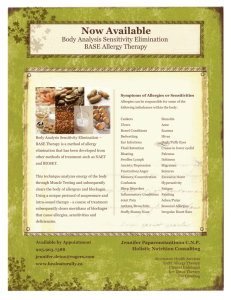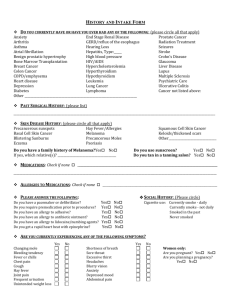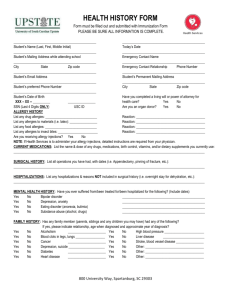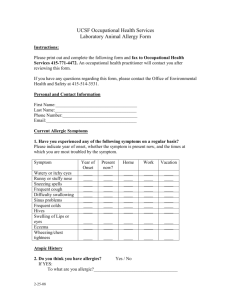Safety Training LABORATORY ANIMAL ALLERGY AWARENESS
advertisement
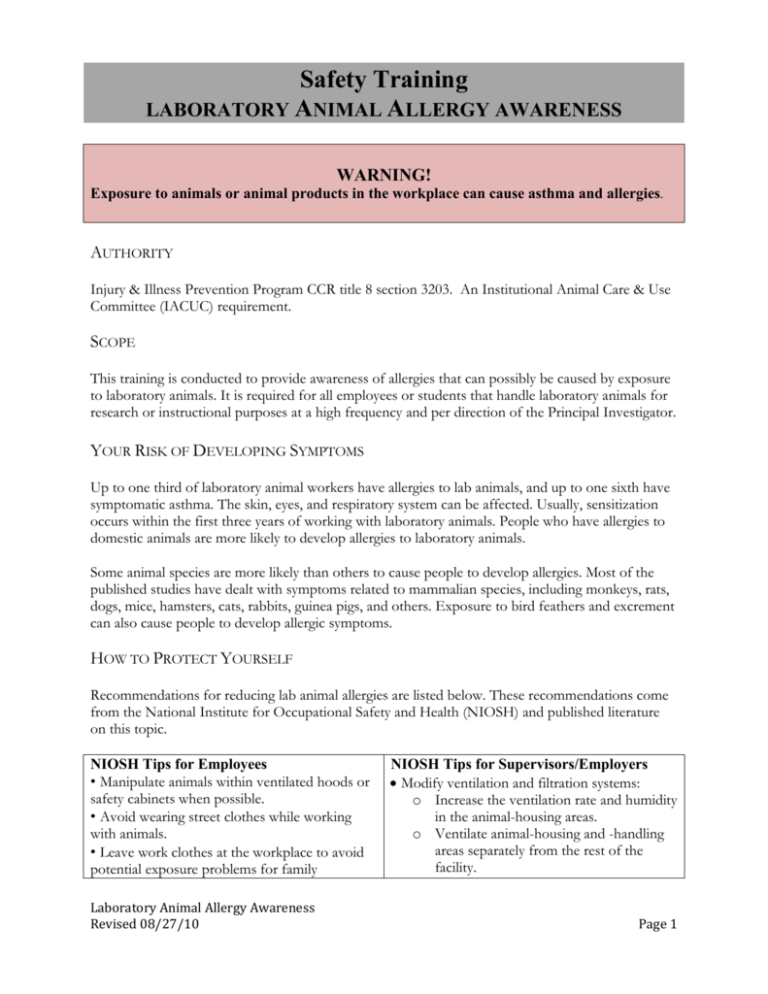
Safety Training LABORATORY ANIMAL ALLERGY AWARENESS WARNING! Exposure to animals or animal products in the workplace can cause asthma and allergies. AUTHORITY Injury & Illness Prevention Program CCR title 8 section 3203. An Institutional Animal Care & Use Committee (IACUC) requirement. SCOPE This training is conducted to provide awareness of allergies that can possibly be caused by exposure to laboratory animals. It is required for all employees or students that handle laboratory animals for research or instructional purposes at a high frequency and per direction of the Principal Investigator. YOUR RISK OF DEVELOPING SYMPTOMS Up to one third of laboratory animal workers have allergies to lab animals, and up to one sixth have symptomatic asthma. The skin, eyes, and respiratory system can be affected. Usually, sensitization occurs within the first three years of working with laboratory animals. People who have allergies to domestic animals are more likely to develop allergies to laboratory animals. Some animal species are more likely than others to cause people to develop allergies. Most of the published studies have dealt with symptoms related to mammalian species, including monkeys, rats, dogs, mice, hamsters, cats, rabbits, guinea pigs, and others. Exposure to bird feathers and excrement can also cause people to develop allergic symptoms. HOW TO PROTECT YOURSELF Recommendations for reducing lab animal allergies are listed below. These recommendations come from the National Institute for Occupational Safety and Health (NIOSH) and published literature on this topic. NIOSH Tips for Employees • Manipulate animals within ventilated hoods or safety cabinets when possible. • Avoid wearing street clothes while working with animals. • Leave work clothes at the workplace to avoid potential exposure problems for family Laboratory Animal Allergy Awareness Revised 08/27/10 NIOSH Tips for Supervisors/Employers Modify ventilation and filtration systems: o Increase the ventilation rate and humidity in the animal-housing areas. o Ventilate animal-housing and -handling areas separately from the rest of the facility. Page 1 members. • Keep cages and animal areas clean. • Reduce skin contact with animal products such as dander, serum, and urine by using gloves, lab coats, and approved particulate respirators with faceshields. • Spend as little time as possible in the room where animals are kept. • Do not eat, drink, or smoke in rooms where animals are housed. • Moisten empty soiled cages before transport. Empty them only in the cleaning area. • Move soiled cages to the cleaning area using a closed transport trolley. If this is not possible, drape the cages with a cover cloth or plastic sheet. o Direct airflow away from workers and toward the backs of the animal cages. o Install ventilated animal cage racks or filtertop animal cages. Decrease animal density. Keep cages and animal areas clean. Use absorbent pads for bedding. If these are not available, use corncob bedding instead of sawdust bedding. Use an animal species or sex that is known to be less allergenic than others. Provide protective equipment for animal handlers: gloves, lab coats, and approved particulate respirators with faceshields. Provide training to workers about animal allergies and steps for risk reduction. Provide health monitoring and appropriate counseling and medical follow-up for workers who have become sensitized or have developed allergy symptoms. Symptoms? Call Risk Management & Safety at 760-750-4502 If respirators are used for protection from aerosolized animal allergens, CSUSM employees must comply with the Respiratory Protection Policy. References 1. Bush, R., Wood, R., and Eggleston, P. "Laboratory Animal Allergy". Journal of Allergy and Clinical Immunology. July 1998: 102: 99 - 109. 2. National Institute for Occupational Safety and Health. Alert: Preventing Asthma in Animal Handlers. January 1998: DHHS (NIOSH) Publication No. 97-116. Laboratory Animal Allergy Awareness Revised 08/27/10 Page 2 ACKNOWLEDGEMENT You will not be permitted to work in CSUSM laboratories until you: A. B. Have read this Laboratory Animal Allergy Safety Handout; Have been instructed in the hazards of working with animals and have had any questions answered I have been trained in Laboratory Animal Allergy Safety: Name (Print)____________________________________ Date _____________ Name (Signature)________________________________ Supervisor/Instructor______________________________ *Return completed ACKNOWLEDGEMENT page to your Supervisor / Principal Investigator and Risk Management & Safety. Laboratory Animal Allergy Awareness Revised 08/27/10 Page 3
